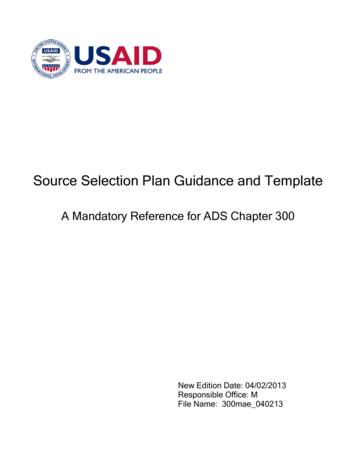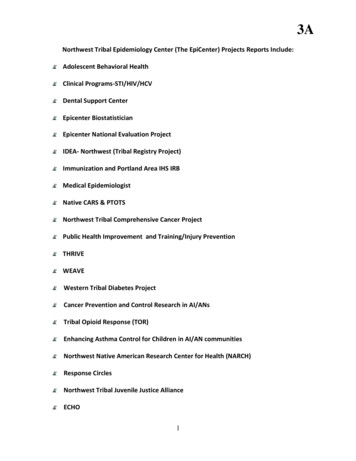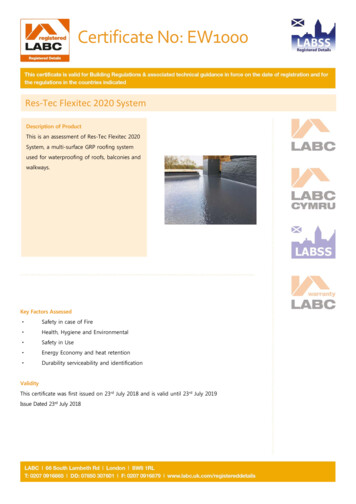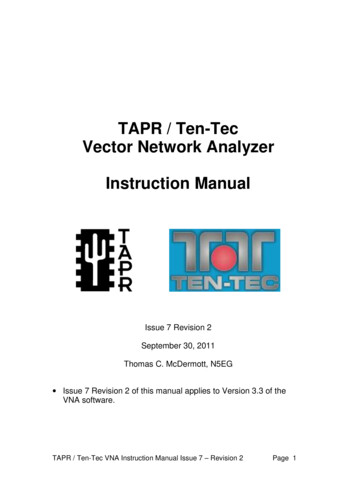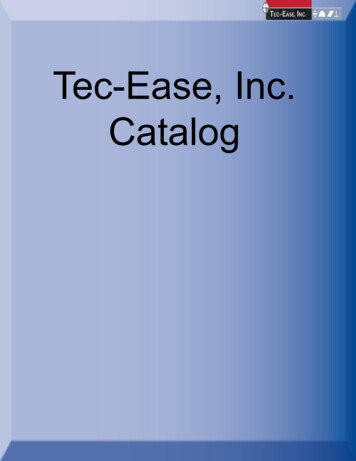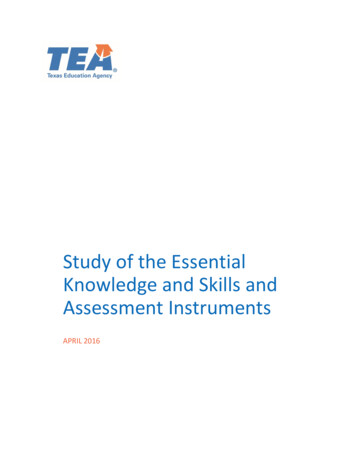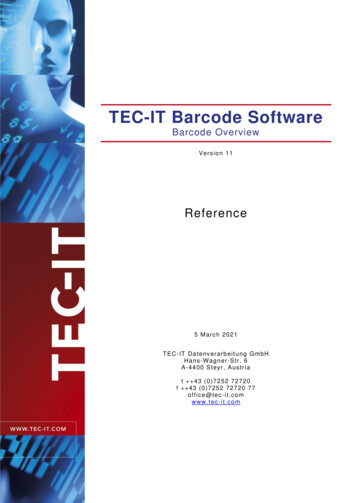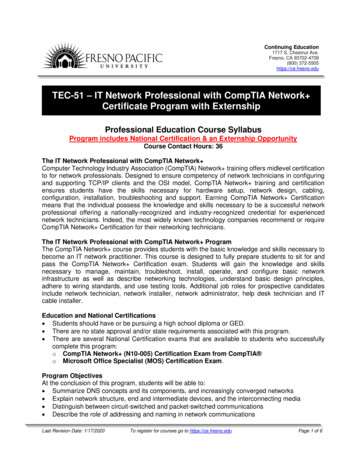
Transcription
Continuing Education1717 S. Chestnut Ave.Fresno, CA 93702-4709(800) 372-5505https://ce.fresno.eduTEC-51 – IT Network Professional with CompTIA Network Certificate Program with ExternshipProfessional Education Course SyllabusProgram includes National Certification & an Externship OpportunityCourse Contact Hours: 36The IT Network Professional with CompTIA Network Computer Technology Industry Association (CompTIA) Network training offers midlevel certificationto for network professionals. Designed to ensure competency of network technicians in configuringand supporting TCP/IP clients and the OSI model, CompTIA Network training and certificationensures students have the skills necessary for hardware setup, network design, cabling,configuration, installation, troubleshooting and support. Earning CompTIA Network Certificationmeans that the individual possess the knowledge and skills necessary to be a successful networkprofessional offering a nationally-recognized and industry-recognized credential for experiencednetwork technicians. Indeed, the most widely known technology companies recommend or requireCompTIA Network Certification for their networking technicians.The IT Network Professional with CompTIA Network ProgramThe CompTIA Network course provides students with the basic knowledge and skills necessary tobecome an IT network practitioner. This course is designed to fully prepare students to sit for andpass the CompTIA Network Certification exam. Students will gain the knowledge and skillsnecessary to manage, maintain, troubleshoot, install, operate, and configure basic networkinfrastructure as well as describe networking technologies, understand basic design principles,adhere to wiring standards, and use testing tools. Additional job roles for prospective candidatesinclude network technician, network installer, network administrator, help desk technician and ITcable installer.Education and National Certifications Students should have or be pursuing a high school diploma or GED. There are no state approval and/or state requirements associated with this program. There are several National Certification exams that are available to students who successfullycomplete this program:o CompTIA Network (N10-005) Certification Exam from CompTIA o Microsoft Office Specialist (MOS) Certification Exam.Program ObjectivesAt the conclusion of this program, students will be able to: Summarize DNS concepts and its components, and increasingly converged networks Explain network structure, end and intermediate devices, and the interconnecting media Distinguish between circuit-switched and packet-switched communications Describe the role of addressing and naming in network communicationsLast Revision Date: 1/17/2020To register for courses go to https://ce.fresno.eduPage 1 of 6
Explain the purpose and function of protocols and standards in network communicationsExplain how protocols enable communications between different network devicesDistinguish between networking protocols and networking standardsExplain the advantages of using a layered model to describe network functionalityDescribe the role of each layer in the OSI reference model and the TCP/IP stackIdentify virtual network componentsDescribe the functions of the three upper OSI model layersDescribe the function of well-known TCP/IP Application Layer protocolsExplain the principles of network client–server operationMicrosoft OfficeNational CertificationUpon successful completion of this program, students would be eligible to sit for the CompTIANetwork Certification Exam from CompTIA and the Microsoft Office Specialist (MOS) exam.Although there are no state approval, state registration or other state requirements for this program,students who complete this program will be prepared and are eligible to sit for this national certificationexam. Students who complete this program are encouraged to complete the externship option withtheir program. Students who complete this program can and do sit for the MOS national certificationexams and are qualified, eligible and prepared to do so.Externship / Hands on Training / PracticumAlthough not a requirement, once students complete the program, they have the ability to participatein an externship and/or hands on practicum so as to practice the skills necessary to perform the jobrequirements of a professional in this field. Students will be assisted with completing a resume and/orother requirements necessary to work in this field. All students who complete this program are eligibleto participate in an externship and will be placed with a participating organization near their location.IT Network Professional with CompTIA N Program Detailed Student Objectives:COMPUTER NETWORKING OVERVIEW Summarize DNS concepts and its components Identify the benefits and challenges of increasingly converged networks Describe the role and impact of networks on daily business and work Explain the structure of a network, including end devices and intermediate devices, and theinterconnecting media Distinguish between circuit-switched and packet-switched communications Describe the role of addressing and naming in network communications Explain the purpose/ function of protocols and standards in network communications Explain how protocols enable communications between completely different networkdevices Distinguish between networking protocols and networking standards Explain the advantages of using a layered model to describe network functionality Describe the role of each layer in the OSI reference model and the TCP/IP stack Identify virtual network components Describe the functions of the three upper OSI model layers Describe the function of well-known TCP/IP Application Layer protocols and their relatedservices Explain the principles of network client–server operationLast Revision Date: 1/17/2020To register for courses go to https://ce.fresno.eduPage 2 of 6
THE TRANSPORT LAYER Explain the operation of TCP Describe network applications that use TCP Explain the segmentation, port addressing, and reliability functions of the Transport Layer Describe the use of port numbers in client-server communications Identify the port numbers of well-known network applications Explain the operation of UDP Describe network applications that use UDPTHE NETWORK LAYER Describe the role of the Network Layer in enabling communication from one end device toanother end device Explain how to group connected devices into networks, internetworks, or subnetworks Describe the function and features of the Internet Protocol Explain the function of gateways in enabling communication into and out of a local network Describe how to apply the hierarchical addressing feature of the Network Layer in allowingcommunication between networks Describe the function of routers in enabling internetworking Explain the features of static routing Describe the advantages and disadvantages of static routing Explain the operation of dynamic routing Describe the features of distance vector and link state routing protocolsIP ADDRESSING Describe the structure and features of IPv6 addresses Calculate an IPv4 addressing scheme given the relevant information and design criteria Explain the use of subnet masks in dividing networks and determining the network and hostportions of an IPv4 address range Convert between 8-bit binary and decimal numbers Explain the structure and features of IPv4 addresses Describe the types and purposes of different IPv4 addresses Describe the properties of IPv4 address classes Explain how network devices are assigned IPv4 addresses Describe the purpose and operation of network address translation Explain the use of Internet Control Messaging Protocol utilities to test and verify networkoperationTHE DATA LINK LAYER Explain the role of the TCP/IP Network Access Layer in data transmission Describe different types of media access controls Describe how the Data Link Layer prepares data for transmission on network media Explain the process of encapsulating packets into frames to facilitate media access Describe the Data Link Layer and Physical Layer features of the Ethernet standard Explain the functions of the fields of the Ethernet frame Describe the features and operation of Ethernet media access control Explain Address Resolution Protocol Explain the Ethernet switch frame-forwarding process Describe the purpose and features of virtual local area networks Describe the purpose and operation of Spanning Tree Protocol Describe wide area network technologiesLast Revision Date: 1/17/2020To register for courses go to https://ce.fresno.eduPage 3 of 6
THE PHYSICAL LAYER Describe the configuration and operation of a wireless network Differentiate between logical network topologies and physical network topologies Describe the purpose of Physical Layer encoding and how signaling enables bits to betransmitted across the local media Explain how data transfer rates are measured Identify components of network cabling distribution Identify cabling types, standards, and ports used for network connections Identify the characteristics of copper network media Describe common uses of copper network media Identify the characteristics of fiber network media Describe common uses of fiber network media Identify the characteristics of wireless network media Describe common uses of wireless network media Describe the components of a wireless local area network Compare wireless standardsNETWORK SECURITY Describe the requirements of a basic firewall to control specified network access Identify common security threats to computer networks Describe methods to mitigate security threats to computer networks Describe methods to control access to a network Explain methods of user authentication Describe various types of network security appliances and methods Explain the implementation of appropriate wireless network security measuresMOBILE APPLICATIONS Plan a basic network in accordance with requirements Explain the purpose of network design documentation Implement a basic network in accordance with a design Explain the purpose of configuration documentation Describe the use of network software tools to test and verify network operation Describe the use of appropriate network monitoring resources to analyze traffic Implement a consistent and logical network troubleshooting methodology Describe the use of appropriate hardware and software tools to troubleshoot networkconnectivity issues Explain how to troubleshoot common router, switch, and wireless network problemsMICROSOFT OFFICE Use an integrated software package, specifically the applications included in the MicrosoftOffice suite Demonstrate marketable skills for enhanced employment opportunities Describe proper computer techniques for designing and producing various types ofdocuments Demonstrate the common commands & techniques used in Windows desktop List the meaning of basic PC acronyms like MHz, MB, KB, HD and RAM Use WordPad and MSWord to create various types of documents Create headings and titles with Word Art Create and format spreadsheets, including the use of mathematical formulas Demonstrate a working knowledge of computer database functions, including putting,processing, querying and outputting dataLast Revision Date: 1/17/2020To register for courses go to https://ce.fresno.eduPage 4 of 6
Define computer terminology in definition matching quizzesUse the Windows Paint program to alter graphicsUse a presentation application to create a presentation with both text and graphicsCopy data from one MS Office application to another application in the suiteUse e-mail and the Internet to send Word and Excel file attachmentsDemonstrate how to use the Windows Taskbar and Windows TooltipsExplain how copyright laws pertain to data and graphics posted on the InternetTake the college computer competency test after course completionFollow oral and written directions and complete assignments when working under timelimitationsFresno Pacific University Student Learning Outcomes (FPU-SLO)FPU-SLO 1FPU-SLO 2FPU-SLO 3FPU-SLO 4FPU-SLO 5FPU-SLO 6FPU-SLO 7FPU-SLO 8FPU-SLO 9FPU-SLO 10Student Learning Outcomes Oral Communication: Students will exhibit clear,engaging, and confident oral communication – in both individual and groupsettings – and will critically evaluate content and delivery components.Written Communication: Students will demonstrate proficient writtencommunication by articulating a clear focus, synthesizing arguments, and utilizingstandard formats in order to inform and persuade others.Content Knowledge: Students will demonstrate comprehension of contentspecific knowledge and the ability to apply it in theoretical, personal, professional,or societal contexts.Reflection: Students will reflect on their personal and professional growth andprovide evidence of how such reflection is utilized to manage personal andvocational improvement.Critical Thinking: Students will apply critical thinking competencies bygenerating probing questions, recognizing underlying assumptions, interpretingand evaluating relevant information, and applying their understandings to newsituations.Moral Reasoning: Students will identify and apply moral reasoning and ethicaldecision-making skills, and articulate the norms and principles underlying aChristian world-view.Service: Students will demonstrate service and reconciliation as a way ofleadership.Cultural and Global Perspective: Students will identify personal, cultural, andglobal perspectives and will employ these perspectives to evaluate complexsystems.Quantitative Reasoning: Students will accurately compute calculations andsymbolic operations and explain their use in a field of study.Information Literacy: Students will identify information needed in order to fullyunderstand a topic or task, explain how that information is organized, identify thebest sources of information for a given enquiry, locate and critically evaluatesources, and accurately and effectively share that information.Continuing Education Student Learning Outcomes (CE-SLO)CE-SLO 1Demonstrate proficient written communication by articulating a clear focus,synthesizing arguments, and utilizing standard formats in order to inform andpersuade others, and present information applicable to targeted use.Last Revision Date: 1/17/2020To register for courses go to https://ce.fresno.eduPage 5 of 6
CE-SLO 2CE-SLO 3CE-SLO 4CE-SLO 5CE-SLO 6Demonstrate comprehension of content-specific knowledge and the ability toapply it in theoretical, personal, professional, or societal contexts.Reflect on their personal and professional growth and provide evidence of howsuch reflection is utilized to manage personal and professional improvement.Apply critical thinking competencies by generating probing questions, recognizingunderlying assumptions, interpreting and evaluating relevant information, andapplying their understandings to the professional setting.Reflect on values that inspire high standards of professional and ethical behavioras they pursue excellence in applying new learning to their chosen field.Identify information needed in order to fully understand a topic or task, organizethat information, identify the best sources of information for a given enquiry,locate and critically evaluate sources, and accurately and effectively share thatinformation.Last Revision Date: 1/17/2020To register for courses go to https://ce.fresno.eduPage 6 of 6
The IT Network Professional with CompTIA Network Computer Technology Industry Association (CompTIA) Network training offers midlevel certification to for network professionals. Designed to ensure competency of network technicians in configuring . Continuing Education 1717 S. Chestnut Ave. Fresno, CA 93702-4709 (800) 372-5505 https://ce .
